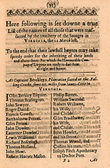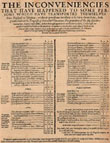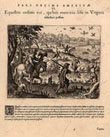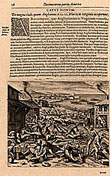Settlement Encouraged In the first decades of the seventeenth century England was widely perceived as overpopulated. Repeated harvest failures and outbreaks of plague made emigration to America an option for many who would otherwise not have considered leaving. When it became clear that in Virginia wealth was not going to come from trade with the Indians, but rather from the development of commodities produced by cultivating the land, colonial leaders began to revise the old settlement model. Instead of a small military unit—the "outpost" of the early years when trade with the Indians was the primary focus—large-scale cultivation required large-scale migration of English labor. To make life in Virginia more appealing, land ownership, attainable by only a fortunate few in England, was offered on easy terms. Offered as well were provisions for greater local economic and political autonomy than was usual in England. |
||
[26] Supply List for Virginia The Company began to send over thousands of new settlers. This pamphlet lists supplies sent to the colony in 1619, as well as the delivery list of 1620. It also provides the names and the amount invested by each "adventurer" (i.e., investor) in the Virginia project. |
||
[27] What to Pack? In the scramble to send large numbers of people to Virginia on short notice costly mistakes were made. Many arrived without proper supplies, food, or clothing, and colonists were often sent at the wrong time of year, in the spring instead of the fall. The warm seasons were the times of greatest mortality on the Chesapeake and many "unseasoned" newcomers died shortly after their arrival. |
||
[25] Idyllic Vision of Virginia Overly optimistic written and pictorial descriptions of the country lured the unwary by presenting Virginia as a kind of "no work required" land of milk and honey. |
||
Strained to the Breaking Point |
||
[28] "The massacre of 1622." Theodor de Bry. Grands voyages. part 10 (Frankfurt, 1634). The Indians now realized how threatening an established and expanding English presence would be to their way of life. Undercurrents of hostility came to a head on March 22, 1622, with the massacre of the colonists around Jamestown. Some plantations received last-minute warnings from Indian friends, but few English managed to escape. The massacre put a damper on English settlement for a decade. |
||
 |
[29] Aftermath of 1622 English pamphlet-writers reacted to the news of the massacre with horror. Waterhouse said that the colonists were too friendly with the Indians and had been lulled into a false sense of security. Here he lists the names of the 347 English dead and gives his views on the way to deal with the Indians. After March 1622, the English in Virginia embarked on a program of guerrilla warfare against the Native Americans that would last a decade. “Because the way of conquering them is much more easie than of civilizing them by faire meanes, for they are a rude, barbarous, and naked people, scattered into small companies, which are helps to victorie, but hinderances to civilitie: besides that, a conquest may be of many, and at once.” |
|
[30] Marriage among the Colonists “If they [unmarried colonists] will marrie, they shall not easily finde with whom, unlesse it be with the natives of those countries, which haply wil be nor handsome nor wholesome for them, certainly profitable and convenient (they having has no such breeding as our women have) it cannot be.” |
||
| Exhibition prepared by Susan Danforth, Curator of Maps and Prints, John Carter Brown Library. On view in the Reading Room August to November 2007. |

 |
||||||
|---|---|---|---|---|---|---|
| France and Spain on the North American Coast
|
Stirring up English Interest
|
The Beginning of the Virginia Venture
|
A Second Chance for Jamestown
|
Settlement Encouraged
|
Virginia Commodities
|
|




